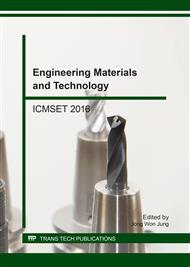p.214
p.220
p.225
p.231
p.236
p.242
p.248
p.256
p.262
The Effect of Silane Coupling Agent on the Properties of Natural Rubber Filled with Waste Silicon Carbide
Abstract:
The effect of a silane coupling on curing characteristics, mechanical properties, abrasion behavior and swelling behavior of waste silicon carbide filled natural rubber compounds was investigated in the concentration 3%, 6%, 9%, 12% and 15% by weight of the particles. The waste silicon carbide content in this study was fixed at 30 phr in order to reveal the influence of silane-69 used to modify silicon carbide. The rubber compounds were prepared using a laboratory two roll mill with temperature maintained at 50°C. The curing characteristics of the composites were determined and the composites were vulcanized at 160°C using a hot press. The properties of the natural rubber compounds such as modulus at 200% elongation, stress at peak, hardness, abrasion resistance and swelling behavior were studied. Results indicate that the maximum torque of the natural rubber compounds increased with increasing silane-69 content whereas the silane-69 can be used without much effect on the scorch time and cure time. Increasing silane-69 content also gives natural rubber compounds better resistance towards swelling and increases the modulus at 200% elongation, tensile strength, hardness and abrasion resistance. The dispersion morphology of silicon carbide in the natural rubber composites was observed by scanning electron microscopy. The modified particles with improved interfacial adhesion between waste silicon carbide and natural rubber. Improvement in mechanical properties of the composites was obtained.
Info:
Periodical:
Pages:
236-241
Citation:
Online since:
June 2017
Authors:
Price:
Сopyright:
© 2017 Trans Tech Publications Ltd. All Rights Reserved
Share:
Citation:


